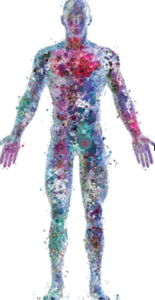Science Seen Physicist and Time One author Colin Gillespie helps you understand your world.
Let’s Feed Our Genes
New science is using genetic analysis to discover more of who we are. We now know most of our cells are bacteria. Until recently we knew little about what they do. Mostly we get rid of them as best we can. This turns out to be a major oops. In a previous post I reviewed how microbes provide you with essential services. Now we learn that you and your microbes are a single ecosystem and you are likely putting it at risk.
cells are bacteria. Until recently we knew little about what they do. Mostly we get rid of them as best we can. This turns out to be a major oops. In a previous post I reviewed how microbes provide you with essential services. Now we learn that you and your microbes are a single ecosystem and you are likely putting it at risk.
Let’s start with some basic facts. You are a cooperative enterprise of about a hundred trillion cells. Ninety percent of them are bacteria. You have maybe a thousand kinds of them. Most of them inhabit your intestines. Between them, their DNA encodes about a hundred times more genes than does your “own” DNA. These genes enable the bacteria to survive and thrive inside you. They also make many of those same bacteria do good things that may surprise you. For example, a new study shows a 3-months-old child who lacks four particular kinds of gut bacteria will be at high risk of asthma by the age of one. A child whose gut has high levels of all four kinds will not get asthma. This is but one of many ways in which our bacteria shape our lives.
How are you to understand your personal relationship with your bacteria? The old view said your DNA shapes you, including your internal environment. It is a somewhat isolated ecosystem. Bugs that like your ecosystem will live and multiply there. The new view realizes that your bugs compete with each other for nutrients, devise ways to evade your immune system, build their own niches, and otherwise modify your (and their) ecosystem. That is, each has its own survival strategy; each affects the others; and they all affect us.
If you have a healthy internal ecosystem, it protects you in many ways. But when your ecosystem changes this can expose you to chronic illness. A British microbiology team says, ‘The human gut harbors a large and complex community of beneficial microbes that remain stable over long periods. This stability is considered critical for good health but is poorly understood.’ Instability can lead to a wide range of diseases. Canadian journalist Wency Leung says, ‘An imbalance in the composition of microbes in our guts is now believed to play a role in a staggering array of ailments and disorders, from allergies to autism, obesity and depression.’ Indeed, it is now possible to diagnose some of these conditions by measuring the genetic activity in a stool sample.
So science now offers us a new understanding of ourselves. It sees each one of us—host and microbiome together—as a whole ecosystem. On this view, your DNA’s epigenetic landscape (the genes that are switched on) and the functioning genes of your microbiome run your body jointly. An American team of microbiologists says that ‘humans are superorganisms whose metabolism represents an amalgamation of microbial and human attributes.’
This is now known as the “community genetics view”. We should get used to it. It can help us to live better by understanding how we hurt our microbiomes. Each of us is unwittingly conducting uncontrolled experiments with our own community genetics. Such factors as suburban environments, unnecessary antibiotics, obsessive hygiene, and most of all low-fiber diets increasingly leave our genetic community to chance acquaintance. It should be no surprise that each of the mostly incurable disorders Leung mentions is often in the news because its incidence is on the rise.
Sources:
Katharine Z. Coyte, Jonas Schluter & Kevin R. Foster (2015), “The ecology of the microbiome: Networks, competition, and stability”, Science, Washington: AAAS, vol. 350, p. 663; http://www.sciencemag.org/content/350/6261/663.full
Marie-Claire Arrieta et al. (2015), “Early infancy microbial and metabolic alterations affect risk of childhood asthma”, Science Translational Medicine, vol. 7, p. 307; http://stm.sciencemag.org/content/7/307/307ra152
Wency Leung (2015), “Say hello to your little friends: Making sense of gut bacteria”, The Globe and Mail, June 8; http://www.theglobeandmail.com/life/health-and-fitness/health/whats-in-our-guts-making-sense-of-the-microbiome/article24822224/
Stephen R. Gill et al. (2006), “Metagenomic Analysis of the Human Distal Gut Microbiome”, Science, vol. 312, p. 1355; http://www.sciencemag.org/content/312/5778/1355.full
Edward van Opstal & Seth Bordenstein (2015), “Rethinking heritability of the microbiome”, Science, Washington: AAAS, vol. 349, p. 1172; http://www.sciencemag.org/content/349/6253/1172.full
Image credit: Science, http://www.sciencemag.org/content/349/6253/1172/F1.expansion.html

No comments yet.